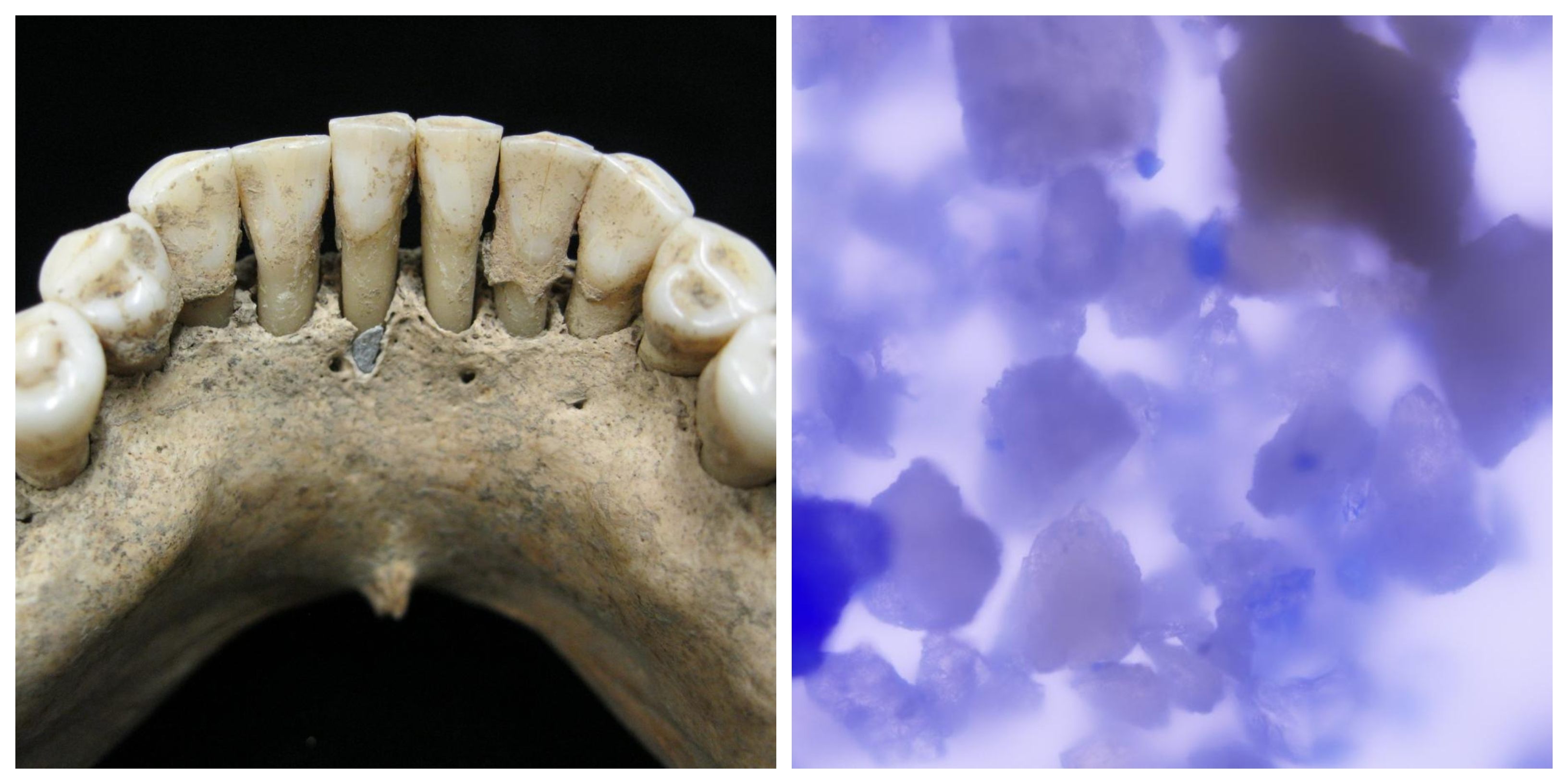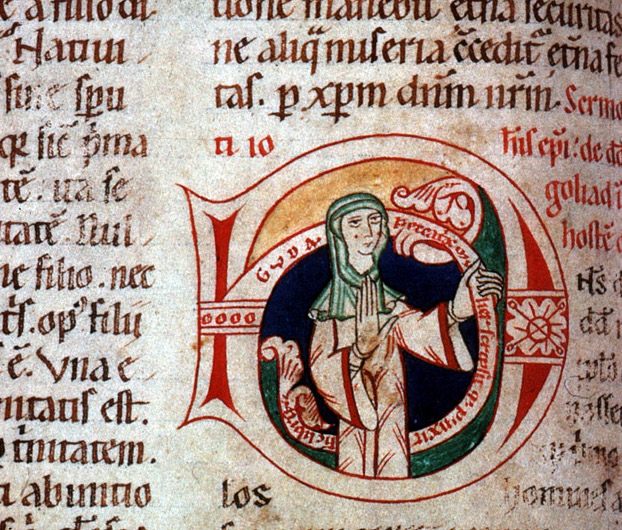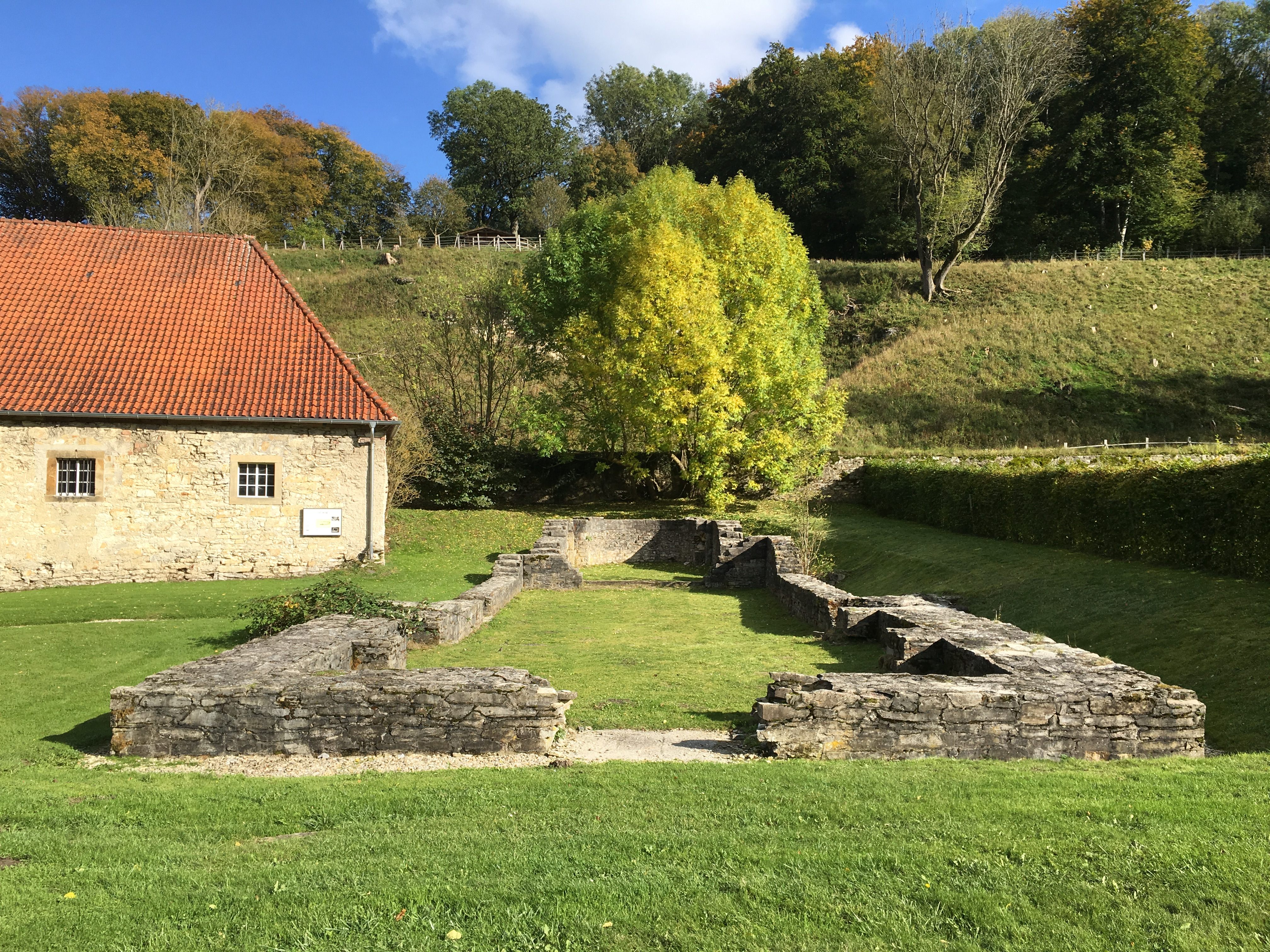How a Blue Tooth Led Scholars to a Medieval Manuscript Mystery
And illuminated the hidden contributions of a female artist.

At first glance, there was nothing unusual-looking about the old tooth, or the skeleton of the woman it came from. Neither tooth nor bones showed signs of deformity, disease, or trauma. The tooth was pointy, yellowed, average—and that’s exactly why scientists wanted a closer look.
The plan had been to use the tooth—buried with its onetime owner in a monastery cemetery in Dalheim, Germany in the 11th or early 12th century—to better understand diet and health in the Middle Ages. Teeth, particularly gunk-encrusted ones, can reveal all sorts of habits and behaviors, because tartar, or hardened plaque, is “the only part of your body that fossilizes when you’re still alive,” says Christina Warinner, an archaeogeneticist at the Max Planck Institute for the Science of Human History in Germany. Bacteria, pollen, and little bits of food can all be trapped in this matrix, making teeth “a little time capsule of your life history,” she says. While archaeologists are often focused on pottery sherds or pieces of metal or stone, Warinner adds, “small artifacts, the kind that are too small to see, often preserve better than anything else.” As the team would discover, this microscopic debris can hold puzzles and clues about life and labor centuries ago.
Warinner and her collaborators first looked at the tooth, from the woman designated B78, under a microscope for a window into the daily life of the women who lived and worked in the small monastery. But the researchers soon realized they were looking at something more unusual. According to Warinner, her colleague Anita Radini, an archaeologist at the University of York, said, “I don’t know what’s going on, but it’s blue.” At first, Warinner thought this might be an exaggeration—maybe it was just a little grayish? But it turned out to be flecked with bits that were resplendently, unmistakably blue—the color of a cloudless sky. “Under the microscope,” Warinner says, “it was clear [B78] had been rather extraordinary.”

Radini, Warinner, and their team analyzed some of the several hundred blue particles suspended in B78’s hardened plaque, and determined them to be lazurite, the naturally occurring mineral that gives lapis lazuli its brilliant blue hue. They suspected that the crystals came from interacting with a rich ultramarine pigment, made by grinding lapis lazuli into a fine powder. The semiprecious stone had been traded into Europe from Afghanistan, perhaps through Alexandria, Venice, or other trading hubs. But how did it get into B78’s mouth, and stay there?
In a new paper in Science Advances, the team offers a number of theories, which could help rewrite what we know about the roles that women played in the creation of Middle Age manuscripts. The authors suggest that the pigment got onto B78’s teeth as she habitually touched paintbrush bristles to her mouth to taper them to a point, or when she prepared the blue pigment, a process that is known to create clouds of azure dust. In either case, they suggest, she was likely to have been intimately involved with illuminating manuscripts, either decorating them herself or prepping the materials that others used.
“I can’t think of another reason a sufficient quantity of lapis would be ingested, unless it was supposed to have apotropaic [magical or protective] qualities,” says Suzanne Karr Schmidt, curator of rare books and manuscripts of the Newberry Library in Chicago, who wasn’t involved in the research. The paper’s authors also consider and dismiss the possibilities that the pigment was consumed for a medicinal purposes (since the practice wasn’t widespread in Germany at the time), or accidentally ingested during “devotional osculation,” or the ritualistic kissing of an illuminated prayer book. (These kissing rituals didn’t become particularly popular until the 14th and 15th centuries, the authors note, and probably would have also resulted in the kisser picking up other pigments or materials beyond the dazzling blue.)

For years, scholars believed that women weren’t often actively engaged in the process of creating illuminated manuscripts, the creators of which frequently went uncredited. “There really aren’t many signed illuminations from any period, though I can’t think of any female examples,” Schmidt says. In that era, she says, women were more often associated with textiles or, occasionally, from the 1400s on, embellishing manuscripts with hand-coloring or borders. Only 1 percent of books made prior to the 12th century can be attributed to women, the authors write, and historically it has been assumed that uncredited examples were made by men.
But Alison Beach, a historian at Ohio State University and a coauthor on the paper, has turned up a few examples of female illuminators staking a claim to their work, and compared these known examples against unsigned ones. “Start with what you know,” Beach says, “a name, a hand, and move away from there and try to make a match.” By comparing handwriting, she has been able to attribute some unsigned manuscripts to female illuminators. Overall, “women produced far more books than has been appreciated before,” Warinner says. The clues tend to cluster in Germany, Beach says, and a single 12th-century female scribe in Bavaria is known to have produced more than 40 books, including an illuminated gospel. Warinner and her collaborators argue that the stained tooth could begin to illuminate the hidden artistic contributions other women made during this period.
Further information about the women of Dalheim has vanished into the ether. It began as a parish church, and then became a female monastery, home to roughly 14 women at a time. They were buried, without gravestones or other identifying information, in the cemetery. Over the years—save for a few passing mentions in a couple of letters—it was largely forgotten after a 14th-century fire swallowed the complex and any records it might have held. Later, monks formed a new monastery there, and today the grounds are home to museum of monastic history, where the foundation of the women’s long-gone quarters are preserved. “The case of Dalheim raises questions as to how many other early women’s communities in Germany, including communities engaged in book production, have been similarly erased from history,” the study authors write. Beach says that we’ll never know exactly how many manuscripts women worked on, but Warinner believes that incisors, molars, or bicuspids might hold surprising other insights about women’s life and work—stories that were once thought gone for good.















Follow us on Twitter to get the latest on the world's hidden wonders.
Like us on Facebook to get the latest on the world's hidden wonders.
Follow us on Twitter Like us on Facebook